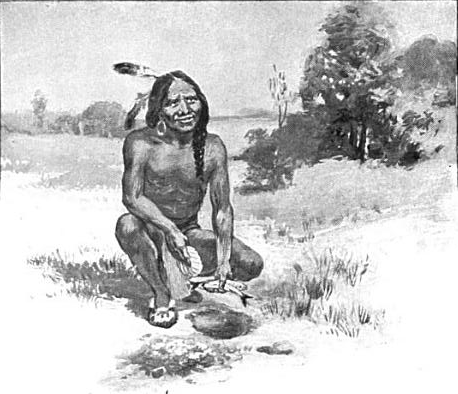In an amazing turn of events, while Captain Thomas Dermer was on a voyage to Newfoundland in 1616, he stumbled upon Squanto (Tisquantum), an Amerindian from Cape Cod who had been taken captive by Thomas Hunt in 1615. Incredibly, Squanto had been sold as a slave by Hunt in Spain, rescued by monks, and taken to London by the merchant John Slaney, who had then sent him to Newfoundland as a guide. Dermer immediately realized that Squanto could be invaluable to him as an interpreter in his expeditions and took him back to England. There is no record as to whether he made this additional move willingly.
In 1619, Dermer and Squanto were sent by Ferdinando Gorges to fish, further explore the natural resources of New England, and re-initiate trade with the Indigenous people along that coast. At the end of this expedition, Squanto was to be returned to his original home at Patuxet (Plymouth).
The expedition started at Mohegan in the Gulf of Maine where Dermer and Squanto left most of the crew to fish and they set sail southward. They traveled along the New England coast in a small pinnace of five tons. To their horror, when they eventually arrived at Patuxet, they found that every man, woman, and child had been wiped out by the plague. Epidemics had swept across New England and the Canadian Maritimes between 1614 and 1620 and had devastated the Wampanoag and Massachusett, with mortality reaching 100% in many mainland villages.
After surveying the tragedy at Patuxet, Dermer and Squanto, headed inland to search for survivors and information on what had happened. After a day of travel, they found the still-inhabited village of Namasket (Middleton, MA) and learned of the tragedy that had destroyed the local population. Dermer and Squanto then returned to Patuxet and began exploring the islands of Boston Harbor looking for gold. In mid-June, Dermer headed back to Monhegan leaving Squanto behind. Squanto would later play a central role as an interpreter and guide for the Pilgrims when the Mayflower landed in Plymouth Bay in 1620.
At Mohegan, Dermer dispatched the fishing boats to England and then continued to explore the Eastern coastline in his pinnacle, traveling from Monhegan back towards Cape Cod. During the voyage south, Dermer and crew had to endure many storms, leaks, and attacks. At one critical point, they had to ditch most of their provisions overboard to keep control of the ship before it was dashed upon the rocks.
Dermer’s relations with the local people became very tenuous without Squanto’s help. On the southern tip of Cape Cod, Dermer, and his crew were attacked by a group of Nauset. Dermer was only able to escape by holding a leader and two others as hostages. Remarkably, he was able to ransom them back for a few hatchets and a canoe full of corn.
Dermer then departed for Capawack (Martha’s Vineyard) where he encountered another former captive Amerindian, Epenow (also spelled Epanow) who had been kidnapped by Edward Harlow and four others in 1609. After his abduction, Epenow had been shown as a “wonder” in England for a year or so and was eventually acquired by Ferdinando Gorges and kept on his estate. He got back to Capawak by tricking his “host” Gorges into thinking that he knew the location of a gold mine and then escaped when Gorges sent a mission to find it.
Dermer headed next to Plymouth Harbor where he and his crew wintered in 1619. Dermer would be the last of a long line of explorers who visited Plymouth Harbor before the Pilgrims arrived in 1620. Englishmen Martin Pring and John Smith had been in the bay, and Bartholomew Gosnold had passed by but had not landed. The Frenchman, Sieur de Monts, had also made short stays there.
In the spring Dermer headed north to New England and found that the Dutch had arrived in Manhattan and he warned them that they were trespassing on English ground. He then traveled back to Patuxet, where five months later the Mayflower would arrive carrying 102 Pilgrims.
The final fate of Dermer is a bit cloudy. Most reports suggest he was mortally wounded in an ambush while trying to trade with Amerindians. Epenow may have led this ambush, as Dunn (1993) tells the story: “In 1620 Dermer returned to New England according to Gorges, stopping at Nautican or Nantucket, and Martha’s Vineyard, where Epanow spoke about his escape in English and laughed. Then, after questioning Dermer about Gorges’ intent, Epanow lost faith, and he and his companions attacked Dermer and his crew. Dermer received fourteen or fifteen wounds. All of Dermer’s men were slain except for one who had stayed in the boat. While Dermer tried to get into the boat, Epanow and company would have cut off Dermer’s head upon a small cabin in the boat, if Dermer’s man had not rescued Dermer with a sword and escaped with him to Virginia, where Denner died from his wounds or from a disease.”
Illustration: Squanto or Tisquantum teaching the Plymouth colonists to plant corn. From: G. A. Bricker, The Teaching of Agriculture in the High School. New York: Macmillan, 1911. Page 112.
Bibliography:
Burrage, H. S. (1923) Gorges and the grant of the province of Maine 1922: A tercentenary memorial. State of Maine, Portland.
Dermer, T. (1905) [1619] Dermer’s letter to Thomas Purchas, 1619. pp. 127-136. In: Winship, G. P. Sailors Narratives of Voyages Along the New England Coast, 1524-1624.Houghton, Mifflin & Company: Boston.
Dunn, J.P. (1993) Squanto before he met the Pilgrims. Bulletin of the Massachusetts Historical Society 54 (1): 38 – 42.
Hunt, E. (2003) Dermer, Thomas. In: Dictionary of Canadian Biography, vol. 1, University of Toronto/Université Laval, 2023, http://www.biographi.ca/en/bio/dermer_thomas_1E.html.
Mark, J. J. (2021). Jamestown colony of Virginia. World History Encyclopedia. https://www.worldhistory.org/Jamestown_Colony_of_Virginia/
